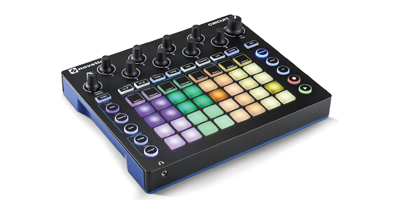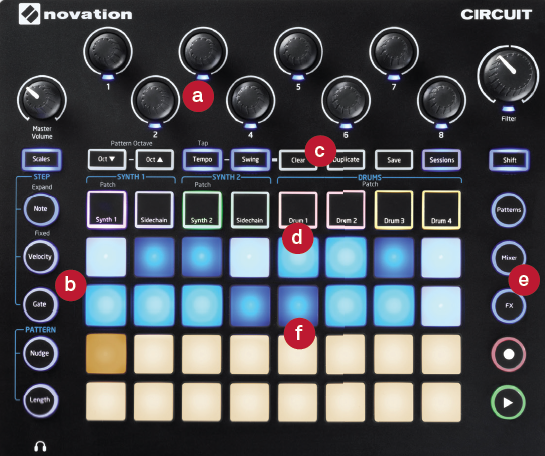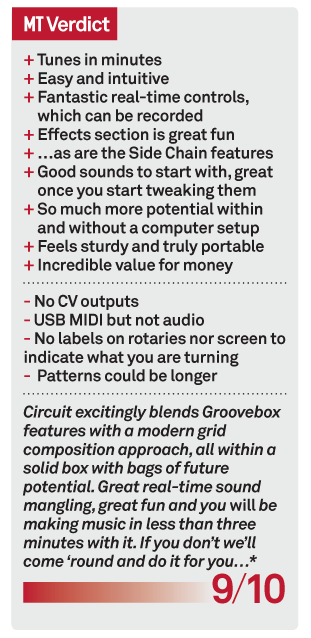Novation Circuit Review
Novation’s launch of 2015 blends the best of grid production with a Groovebox feel and there’s no computer in sight. Andy Jones has no capacity to resist in our world exclusive review of Circuit… Details Price £249.99 Contact +44 1494 462246 Web uk.novationmusic.com You might think that Circuit is just another piece of grid-based […]

Novation’s launch of 2015 blends the best of grid production with a Groovebox feel and there’s no computer in sight. Andy Jones has no capacity to resist in our world exclusive review of Circuit…




Details
Price £249.99
Contact +44 1494 462246
Web uk.novationmusic.com
You might think that Circuit is just another piece of grid-based controller hardware, but it is a lot more than that – and to borrow an already worn out sci-fi phrase: it’s much bigger on the inside.
Grid-based music making is, of course, very much back in vogue and Circuit does channel Novation’s strengths in this area. But while it takes a certain philosophy and design aesthetic from these step-based controllers, its heart lies more with the Grooveboxes so prevalent in music making in the 1990s.
That’s simply because, unlike those step-based controllers – think Launchpads, Push and various Akais – that require a computer partner (or iPad, app, etc), Circuit needs nothing at all. It has a couple of onboard synths based on Novation’s Nova, four sets of drums, effects aplenty and real-time controllers. Switch it on and you will make a tune in three minutes. I can pretty much guarantee this, because I did exactly that…
So what Circuit is really setting out to do is update the 90s and noughties Groovebox and repackage it into a more elegant solution for the 21st century. And while the unit doesn’t require a computer – shuns them even – Novation has half an eye on more computer integration in the future.
Indeed, the company is actively welcoming feedback for Circuit’s further development within all aspects of music production, as we will come to.

You can’t blame Novation for moving away from the computer, but it is ironic that Circuit and other new hardware could be seen to be inspired by software in the first place.
The step sequencing we now find on hardware such as Roland’s AIRA, Korg’s Volcas, and now Circuit, might be spiritually based on the step sequencers used in the 80s, but its resurgence in popularity must be down at least partly to the hardware that controls the software that is Ableton Live. I guess we all move in circles…
Of this new generation of grid-based controllers, I’ve used everything from Push to Tenori-on (Yamaha’s futuristic light/grid instrument from a few years back), so I do understand their appeal. But, and it’s quite a big but: while I like the fun, I’d not turn to any one of them to make a particular piece of music that I have rolling around my head.
Yes, they help you produce tunes very quickly, but the resulting tunes are not always, it must be said, the ones you switched the machines on to make…
But I’ve seen Circuit in action and it could well be the unit I’ve been waiting for: an all-in-one instrument that allows instant composition of music that you want it to make, rather than what it wants you to make, and in a hugely enjoyable way, with batteries if you wish – and without a computer.
Colours, Colours
Opening up Circuit, I can already feel the difference. I do like Novation’s products, but they don’t always feel this good. Circuit’s packaging and the product itself do feel a little different, with the former being a little (just a little) more ‘Apple-y’, and the latter being chunky and solid, combining a lifestyle and practical edge that we rarely see.
Its rubber base feels as if it will sit solidly anywhere you put it. The unit’s multi-coloured lights also fit in with the current fixation by music technology companies to make all products look as if they’ve just stepped off Las Vegas strip, something you may or may not be a fan of.
Personally, I love it, but the colours in this instance are not only garishly attractive but also important in terms of what makes up a song on Circuit, as they define the four main parts of your tune as well as helping you with your edits within parameters such as effects and side-chaining.
So unpacking and switching on Circuit makes for a welcoming and attractive experience. But less than three minutes later, I also had a tune on my hands. Yes, really.
Main Features
On first powering up Circuit, I could easily have downloaded the full instructions (as suggested in the instructions), or registered the product (as also hinted at).
Or I could have just switched the box on and got on with making a tune. I chose the latter, and because of what is surely the unit’s greatest strength I had a half-decent tune – albeit a loop – in no time at all.

It’s pretty obvious what you get and do straight out of the box: there are four drum parts (across bass/snare and two percussion) and two synths. Press Session and Play and you can cycle through 16 demos of various musical genres – songs utilising all four parts. Select an empty Session (one of the 16 at the bottom) and you can quickly fill it with your own sounds.
You will, should even, do this, probably within five minutes of unpacking it, as I did. Simply select each part, press Play and fill in the rest. Each Pattern cycles around 16 parts, and Circuit has 32 pads in which you input your notes. So with the synth parts, the top 16 pads correspond to a keyboard (with selectable scales) and for the rhythm parts the top 16 will be one sound (bass/closed hat), and the bottom another (snare or open hat).
That’s the instant joy of Circuit, but there’s a surprising depth to the unit that is quickly opened up. My absolute favourite parts are the effects and the real-time knobs.
These eight rotaries at the top of the unit edit the currently selected sound in real time by changing some of its key characteristics, such as its envelope, distortion or filter – basically, the most dramatic parameters of a sound.
You can quickly move a sound way away from its preset start (which is easily selectable from 64 on offer by hitting the Shift key and the part in question). And, most importantly, as with any changes you make here and on other features such as the effects below, you can record rotary changes into your pattern – it’s as simple as hitting record as the Pattern cycles.
Deleting these movements or recording over them is just as easy, and this is a key feature and one that really does form the sonic backbone of the unit.
And talking of the effects, this section again allows dramatic changes over your sound, all at the simple touch of button. You get delays (16 across the top two rows of pads) and reverbs (across one row of eight pads at the bottom). Hit the FX button and these rows are lit with one effect from each category highlighted. Select another effect by simply hitting a pad, and adjust its level by using one rotary above it for each part of the song.
An important inclusion, and also an effect, is the Sidechain button, two of which sit by the Synth buttons. Select this and you get seven sidechain effects to play with, where the synth sound plays differently, ducking as the beats (kick or otherwise) play. Again, you can quickly take your pattern on yet another sonic journey here.
Pattern length adjustments can also be made, which also result in some great stuttering effects. Here, you simply touch the pads – up to 16 – to determine your length, and then the part cycles around your chosen duration. You may find that a part drifts out from the others cycling, but it all locks back in when you restart a pattern.
This also highlights that the maximum length of a pattern is 16 notes, which is a drawback if you have a long melody in your head, but common to this style of grid production – and the need for more steps probably rises with the age of the user (I’ll take 48 please).
On a more practical level, but less dramatic sonically, the unit also features several key housekeeping functions, so you get a Mixer that utilises the rotaries for levels; Gate and Velocity buttons that let you set both values by pad; overall Tempo, Swing and Octave settings (the Octave buttons also double to select preset pages); and finally Pattern editing keys, including Duplicate and Erase.
Alternatives
Arturia Beatstep looks the part, but is really a controller and sequencer for both computer DAWs, soft synths and analogue hardware and has no onboard sounds. Standalone, Circuit reminds us of an updated Korg Electribe (the latest of which is the ESX2 at £329), or a couple of combined units from the Volca range (£89 each), albeit more ‘C21’ than the former and a lot larger than the latter.We have to include the Roland AIRA TB-3 (£159) and TR-8 (£359), too, for some very groovy bass and beats, but you’ll splash a lot more cash for both units.

More, more, more
One thing that quickly becomes apparent with Circuit is that its size belies what you can do with it – there’s far more than meets the eye. Novation sees its potential uses and development as very fluid, and the company is actively inviting feedback on how people will use it and want to use it.
An example is that one of its drawbacks is its lack of CV outs, key connectors that are very much de rigour for your bequiffed modular synth user, and something that Arturia’s Beatstep Pro (see review on p85) benefits hugely from.
Novation’s answer is to invite feedback from the modular community, and even before the unit officially goes on sale there’s a potential bridging device (see www.expert-sleepers.co.uk for more info). It’s a refreshing and open approach to product development, and extends to the unit’s use with a computer. Although it’s completely standalone, the USB and MIDI connectivity opens the unit up as a controller and as a sound module in itself (as part of a bigger set-up). Novation is keen that users explore both options.
But getting back to what you get here and now, there are one or two other extras that are well worth discussing. The first is the ability to produce chords, a very neat feature not only useful in composition but in sending out MIDI to other sound sources.
It’s quick to implement – like everything on Circuit – and while it’s not one of the obvious features, it’s something you’ll discover and grow to love as you delve deeper.
A more obvious feature is Circuit’s ability to chain Patterns together to create the songs that make up your Session. You can easily copy Patterns using a kind of pad-based copy-paste command into up to eight slots per song part.
Once you get the hang of it – again, this doesn’t take long – you’ll be adding hats to one part, fills to another, changing melodies and adding effects, and producing complete songs on the fly. Add in some real-time pattern length changing, a dollop of effects and more rotary spinning and you have a full-on live performance on your hands in minutes…
Overview

a: Main Rotaries – These eight rotaries are used to change sound parameters in real time or adjust main song data, such as levels and effects.
b: Scale, step, pattern – Adjust scale and the notes plus their gate and velocitoes. Also adjust pattern length and nudge values.
c: Main Controls – Overall controls for octave, tempo, swing and saving. You choose Sessions for songs and can duplicate Patterns within each.
d: Song Parts – The four main parts are viewable by colour, so purple for Synth 1, green for Synth 2, orange for Drums 1&2 and yellow for Drums 3&4.
e: Patterns, Mixer and FX – Here, you access the Patterns within a Session to repeat or clear them. You also get to mix parts, add FX and the transport controls.
f: 32 Pads – Within drum parts, these double as 16 parts each for two sounds. Within synth parts, the keyboard is at the top while the part played is at the bottom.
Quick, fun and…
It’s this speed that puts Circuit in a class of its own. You can simply do everything you want it to do very quickly and also, crucially, what you want to do. Circuit’s combination of great onboard sounds and pseudo keyboard playing can take what is in your head to a tune fast – something which, as I said earlier, you don’t always get with many grid-based controllers and push-button sequencers.
Sure, much of what you will do will be of the ‘happy accident’ variety, but there’s a depth and control here – and also some very easy paths to follow – that mean you can go in with an idea and realise it.
That said, the random, looping, ‘blimey that sounds great’ stuff does happen… a lot! And while controllers such as Push work (obviously) with software such as Live, and various other hardware (including Novation’s own Launch products) works best with apps and other software, this is different: a truly self-contained musical marvel.
It’s not without some shortcomings, but some of these can be sorted with software upgrades. I would have liked longer patterns to produce longer melodies, plus labels on the rotaries. Lack of screen? No biggie for me, but some will yearn for CV control, especially with such a thriving modular scene.
But Circuit excels so well at what it sets out to do – and its price of £250 is just ridiculous – that you can forget most shortcomings. It is without a doubt about the most musical fun you can have with one box and no computer, and I haven’t made music so quickly in 20-odd years of reviewing gear.

Key Features
- 2-part synth and 4-part drums, Groovebox and step sequencer
- 64 synth patches
- 64 drum sounds
- Polyphony: 6 notes per synth
- 8 Patterns per track, 6 tracks per Session (2 synth, 4 drum), 32 Sessions
- FX: 16 delays, 8 reverbs, 7 side chain, hp/lp filter
- Connections: USB, 2 MIDI jack, 2 1/4” jack, h/pBatteries: 6xAA
- Size (mm): 425 x 285 x 95

